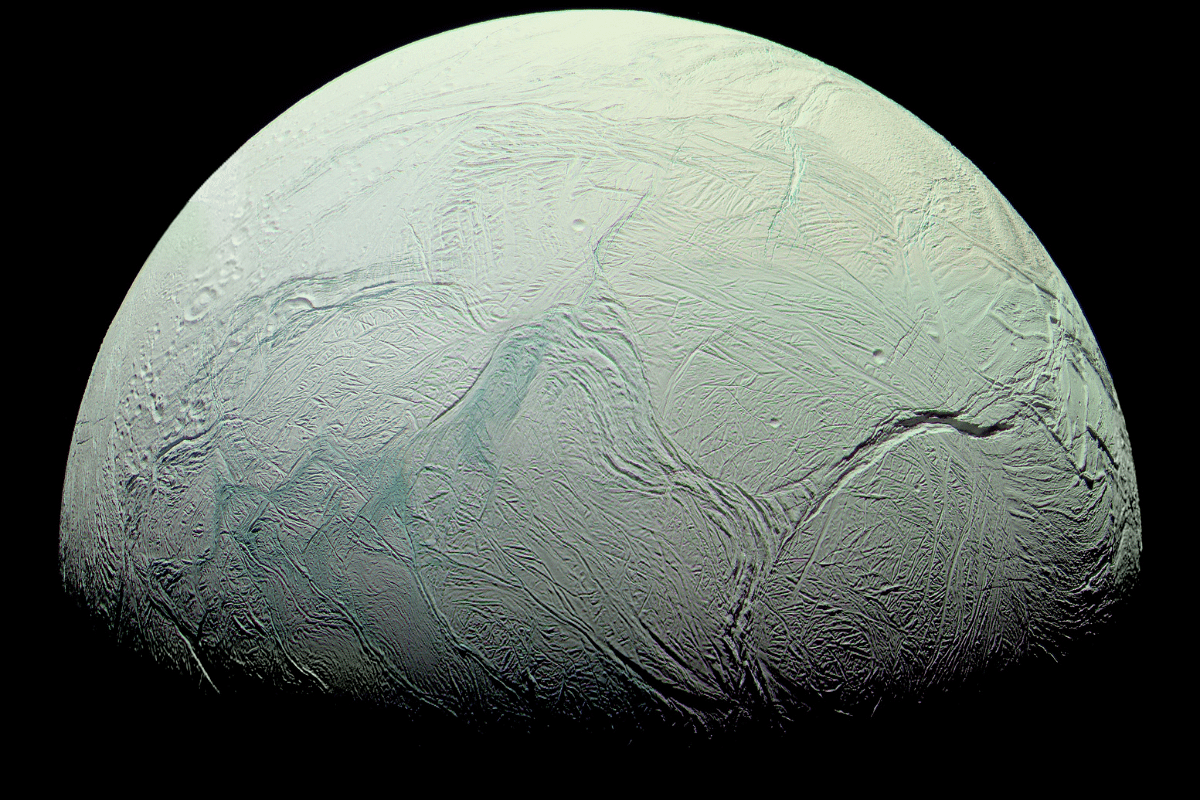News Brief
Phosphorus, Key Building Block For Life, Found On Saturn's Ocean-Bearing Moon Enceladus

Saturn's moon Enceladus in infrared, green, and ultraviolet light, from October 2008. (Image: NASA/JPL/Space Science Institute, Processed by Kevin M Gill)
Life as we know it relies on six elements, one of which is phosphorus, the rarest of the six.
In groundbreaking new research, published on 14 June in the journal Nature, phosphorus has been discovered on a tiny ocean-bearing moon within our solar system for the first time.
Data sent home nearly 15 years ago by NASA's Cassini spacecraft shows an abundance of phosphorus in water geysers that regularly eject into space from Enceladus.
This small moon of Saturn could be one of the most likely places in the solar system where life may exist, making the discovery even more significant.
Enceladus has an icy surface and a vast ocean of liquid water underneath.
Previously, scientists found other essential building blocks of life in the moon's ocean, such as hydrogen, carbon, sulphur, nitrogen, and oxygen; however, phosphorus remained absent from their discoveries.
Phosphorus is essential in forming a DNA molecule's skeleton when combined with sugars and assists in repairing and maintaining cell membranes.
This extraordinary new discovery shows that Enceladus has phosphorus in concentrations at least 500 times higher than Earth's oceans' most significant known phosphorus levels, making it one of the hottest candidates in the search for alien life.
The finding demonstrates that the tiny icy moon satisfies "the strictest requirement of habitability."
Although prior research revealed that there might be phosphorus on Enceladus, this new study indicates the first-ever detection of the crucial ingredient in Enceladus' geysers.
While analysing measurements taken by the Cassini spacecraft and reproducing data in the lab, the researchers found nine grains containing the fingerprint of orthophosphate. This form of phosphorus is crucial for living organisms as it is the only form that they can absorb and use for growth.
Enceladus could have oceans that hold up to 1,000 times more phosphorus than Earth's oceans. According to the researchers, this is because orthophosphate would dissolve at a much higher rate in Enceladus's waters, leading to a higher concentration of phosphorus.
The release of phosphorus on Earth is due to rocks eroding and weathering of dry land; however, this process does not occur on Enceladus. Scientists believe that the rock forming Enceladus' core interacts with the moon's ocean water, which results in the dissolution of significant amounts of phosphorus into the ocean.
Enceladus is known to have a "soda ocean," which allows it to host high quantities of dissolved phosphorus.
Phosphorus is a rare occurrence in natural waters as it reacts easily with positively charged atoms such as calcium. This causes calcium phosphate formation, which locks up the phosphorus, making it impossible to be used by life forms.
The remarkable ability of Enceladus to host dissolved phosphorus is due to its "soda ocean."
Soda oceans, also known as soda lakes, are bodies of water abundant in carbonates, the minerals that contain carbon dioxide and readily form in water.
Carbonates react with other elements such as calcium, liberating phosphorus which can be utilised by potential life forms.
The building blocks of all planets and their moons in the solar system are laden with carbonates. Therefore, any celestial object beyond the outer solar system hosting an ocean in contact with rocks could potentially harbour a soda ocean that could accommodate abundant amounts of phosphates.
Researchers agree that the debate on whether phosphorus, a life-sustaining element, exists on the moon is finally resolved.
Support Swarajya's 50 Ground Reports Project & Sponsor A Story
Every general election Swarajya does a 50 ground reports project.
Aimed only at serious readers and those who appreciate the nuances of political undercurrents, the project provides a sense of India's electoral landscape. As you know, these reports are produced after considerable investment of travel, time and effort on the ground.
This time too we've kicked off the project in style and have covered over 30 constituencies already. If you're someone who appreciates such work and have enjoyed our coverage please consider sponsoring a ground report for just Rs 2999 to Rs 19,999 - it goes a long way in helping us produce more quality reportage.
You can also back this project by becoming a subscriber for as little as Rs 999 - so do click on this links and choose a plan that suits you and back us.
Click below to contribute.
Latest